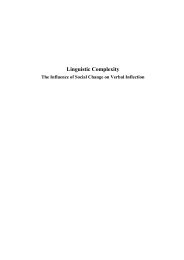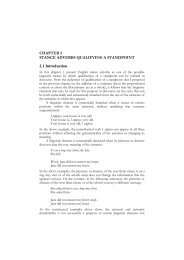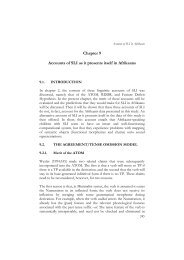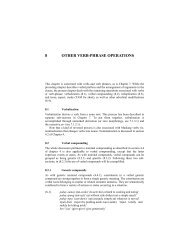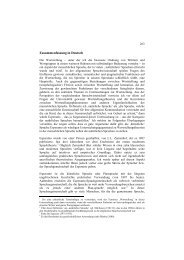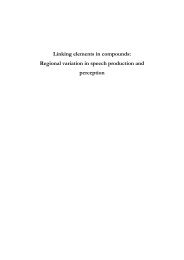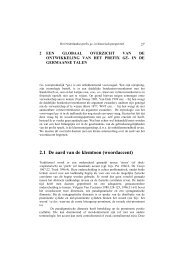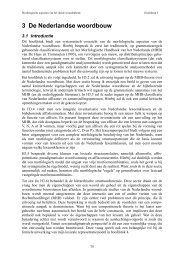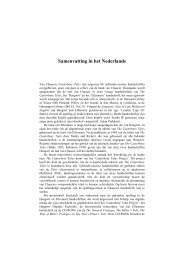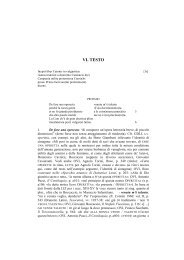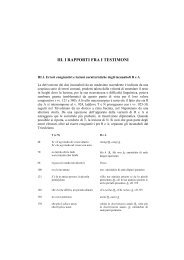Chapter 2 - LOT publications
Chapter 2 - LOT publications
Chapter 2 - LOT publications
Create successful ePaper yourself
Turn your PDF publications into a flip-book with our unique Google optimized e-Paper software.
<strong>Chapter</strong> 2<br />
a double causative derivation. Some instances of –sis- represent a double causative<br />
derivation –s-is; others are to be considered as a single morpheme. Some agentive<br />
intransitive verbs and many transitive verbs permit only the suffixation of –sis-. For<br />
instance, causatives deem-sis- ‘make go’ and kolf-isiis- ‘make laugh’ are single<br />
causatives because forms such as *deem-is- and *kolf-is- are not acceptable. Similarly<br />
single causatives of transitive verbs such as bar- ‘learn’, arg- ‘to see’, hoɗ-<br />
‘embroider’ are bar-sis- ‘teach’, arg-sis- ‘show’ and hoɗ-siis- ‘make embroider’<br />
respectively. The same morpheme could be productively used as a double causative.<br />
For instance, a double causatives of single causatives fiig-s- ‘make run’, gog-s-<br />
‘make dry’, dab-s- ‘make bend’ are fiig-s-is- ‘make somebody to make run someone’,<br />
gog-s-iis- ‘make somebody to dry something’, dab-s-iis ‘make somebody to<br />
bend something’. The /i/ between the two -s-’s varies between short and long. Such<br />
variation is accounted for in terms of vowel length dissimilation rule (see also Lloret<br />
1987:146).<br />
The consequence of using –sis- as a single causative morpheme is that the number<br />
of underlying agents are not always directly linked to the number of –s-’s because<br />
-sis- has two –s-’s; yet, it functions as a single causative morpheme as has<br />
been shown above in causatives such as deem-sis- ‘make go’ and kolf-isiis- make<br />
laugh’. Moreover, there is a geminated form, namely –ss- which is used as a single<br />
causative marker (see also 2.8. in this chapter).<br />
2.2.2. The Morpheme –eess (CAUS 3 )<br />
The morpheme –eess- is one of the of causative morphemes which is suffixed to<br />
adjectival stems such as add- ‘white’ and jab- ‘strong’ to derive add-eess-<br />
‘whiten’ and jab-eess- ‘strengthen’ respectively (see section 2.8.5 in this chapter).<br />
The form –ess and –eess are are accounted for in terms of vowel dissimilation rule<br />
(see Kebede 1994). The morpheme -eess- is distinct from -s-, -is- and –sis- and<br />
cannot be suffixed to bases of intransitives and transitive verbs. The causative morpheme<br />
–eess- is a verbalizing morpheme which is suffixed to adjectival bases such<br />
as guraačča ‘black’, fagoo ‘far’, ɗiyoo ‘near’, etc. This analysis is confirmed when<br />
we observe related Cushitic languages such as Kambaata, Hadiya, Sidama and Afar.<br />
2.3. Structure of the Causative<br />
2.3.1. Double Causatives<br />
In Oromo all causative bases can be doubled. Double causatives refer to indirect<br />
causative events. When one more causative morpheme is suffixed to the causative<br />
base always another external causer is introduced. This is true for causatives of nonagentive<br />
intransitives, agentive intransitives and transitive verbs as shown below:<br />
14



